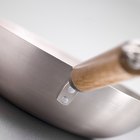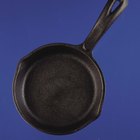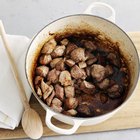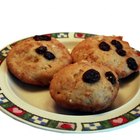
studo58/iStock/GettyImages
Have you ever wondered if it's safe to use your nonstick pans in the oven? The answer is a definite maybe. The safety of Teflon and other nonstick coatings has received much scrutiny over the years, causing many people to question the safety of nonstick cookware both in and out of the oven. Thanks to large amounts of research, we now know when nonstick pans can go in the oven and when they can't.
The Problem With Nonstick
According to Reviewed, manufacturers started adding nonstick coatings to cookware in the 1930s. At the time, it was made with a chemical known as perfluorooctanoic acid (PFOA). As the pans aged or became scratched during use, this PFOA was released into the air and food. Scientists then linked PFOA to cancer, and Healthline reports that manufacturers stopped using it altogether in 2013.
The chemical that replaced PFOA in nonstick coatings was polytetrafluoroethylene (PTFE), which is still in use today. PTFE presents no cancer risk. When heated above 500 degrees Fahrenheit, however, PTFE-coated pans do release toxic fumes that can cause fever, chills and headaches.
Nonstick Skillets in the Oven
The easiest way to determine how your pan will fare in the oven is to check the bottom of it for an oven-safe pan symbol. Many cookware manufacturers will print a picture of an oven on their products to indicate that they're safe to use. If the oven picture on the bottom of your pan has an "X" over it or a circle with a line through it, don't place the pan in the oven.
If your pan has no symbol, you'll have to give it a thorough examination before using it in your oven. Although the body of the pan may do well at high temperatures, plastic, wooden and silicone handles may not fare as well. Glass lids, too, can prove problematic. When in doubt about any part of a pan's oven-safety, take the safe route and forgo the oven.
Nonstick Pan Safety Tips
If you do elect to use your nonstick cookware in the oven, do so only at temperatures below 500 degrees Fahrenheit. Turn on your exhaust fan or crack a window whenever you cook with nonstick cookware to avoid exposing yourself to fumes if the pan gets too hot. Never preheat an empty nonstick pan on your stove, and try to cook on low or medium heat rather than turning your stove burners up to high.
Always avoid using metal utensils with your nonstick cookware as this can scratch the coating, allowing it to release unhealthy chemicals into both the air and your food. Wash nonstick cookware by hand rather than in the dishwasher so that abrasive dishwasher detergents don't chip away at the coating. When the chips, dings and scratches of old age start to show on your nonstick pans, replace them.
The Bottom Line
It's perfectly safe to use most modern Teflon and other nonstick pots and pans in the oven so long as the temperature stays below 500 degrees Fahrenheit and there are no plastic or wooden handles.
If, however, your pans were manufactured prior to 2013, you may want to play it safe and replace them with newer cookware. These older pans may contain the carcinogen PFOA and are likely starting to show their age anyway. It's a good excuse to treat yourself to some new kitchen goodies.
Related Articles

Skillets That Go in the Oven

Anodized Vs. Teflon in Cookware

Does Peroxide & Baking Soda Harm Cast ...

Why Does Food Stick to a Non Stick Pan?

Is Revere Ware Aluminum?

How to Cook in Ceramic Bakeware

Can You Grease a Pan With Canola Oil?

How to Refinish Cast Iron Cornstick Pans

How to Use Smartware Cookware

Glass Pie Pan Baking Tips

Alternatives to a Deep Fryer

How to Cook in a Cast-Iron Corn Muffin ...

Is Corning Cookware Safe?

Can Ceramic Cookware Be Used on ...

How to Clean an Oven Liner

Roshco Silicone Bakeware Instructions

Can I Put Canola Oil in a Spray Bottle?

The Best Types of Pans to Cook ...

Can You Cook Bone-in Chicken in a Metal ...

Are Nickel Lined Pans Safe?
References
Writer Bio
Writing professionally since 2008, Michelle Miley specializes in home and garden topics but frequently pens career, style and marketing pieces. Her essays have been used on college entrance exams and she has more than 4,000 publishing credits. She holds an Associate of Applied Science in accounting, having graduated summa cum laude.